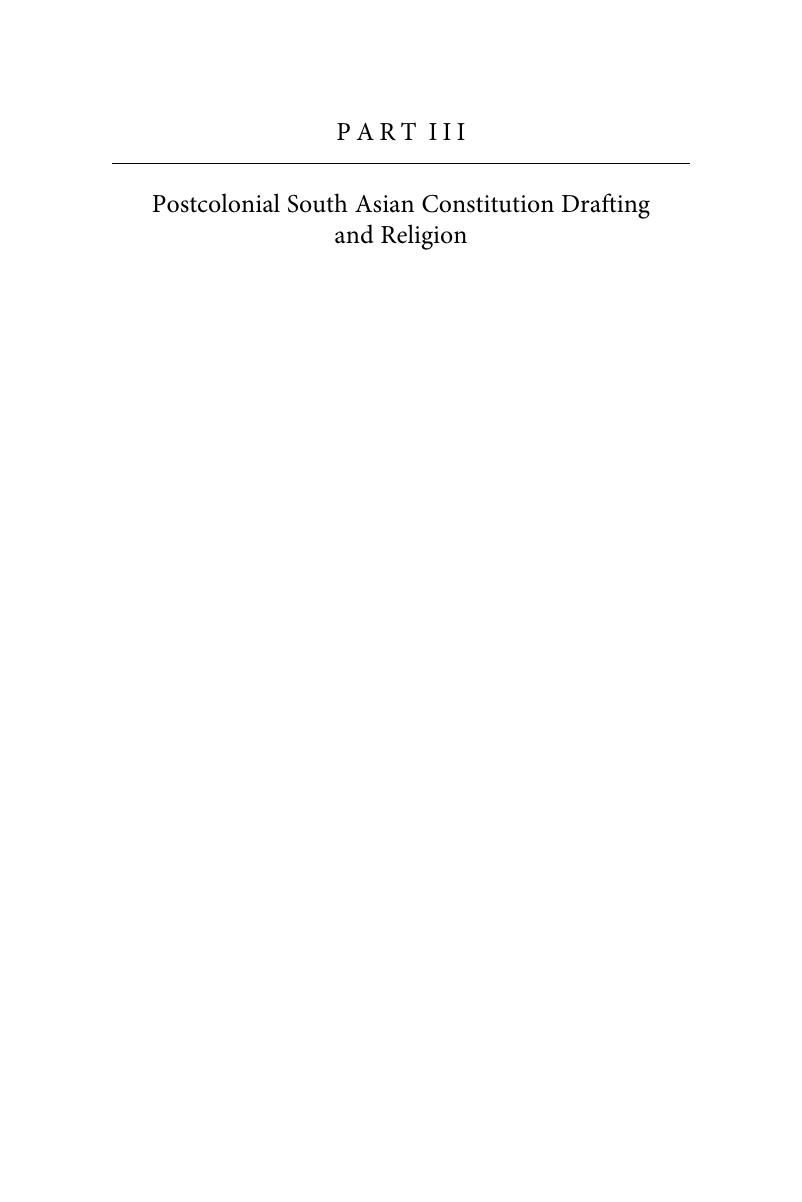Book contents
- Constitution Writing, Religion and Democracy
- Constitution Writing, Religion and Democracy
- Copyright page
- Contents
- Contributors
- Acknowledgements
- 1 Introduction
- Part I Constitution Writing and Religion under Limited Sovereignty
- Part II Postcolonial French-Influenced Constitution Writing and Religion
- Part III Postcolonial South Asian Constitution Drafting and Religion
- Part IV Constitution Writing and Religion in Contemporary Middle East
- Part V Lessons from the Cases
- Index
- References
Part III - Postcolonial South Asian Constitution Drafting and Religion
Published online by Cambridge University Press: 23 February 2017
- Constitution Writing, Religion and Democracy
- Constitution Writing, Religion and Democracy
- Copyright page
- Contents
- Contributors
- Acknowledgements
- 1 Introduction
- Part I Constitution Writing and Religion under Limited Sovereignty
- Part II Postcolonial French-Influenced Constitution Writing and Religion
- Part III Postcolonial South Asian Constitution Drafting and Religion
- Part IV Constitution Writing and Religion in Contemporary Middle East
- Part V Lessons from the Cases
- Index
- References
Summary

- Type
- Chapter
- Information
- Constitution Writing, Religion and Democracy , pp. 177 - 264Publisher: Cambridge University PressPrint publication year: 2017
References
Bibliography
Bibliography
Bibliography
Allah Rakha v. Federation of Pakistan, PLD 2000 FSC 1.
Federation of Pakistan v. Mst. Farishta, PLD 1981 SC 120.
Habibur Rehman v. Federation of Pakistan, PLD 1983 FSC 13.
Hakim Khan v. Government of Pakistan, PLD 1992 SC 595.
Hazoor Bakhsh v. Federation of Pakistan, PLD 1981 FSC 145.
Kaikus v. Federal Government, PLD 1981 FSC 1.
Kaneez Fatima v. Wali Mohammad, PLD 1993 SC 901.
Mohammad Riaz v. Federal Government, PLD 1980 FSC 1.
The State v. Ziaur Rahman, PLD 1973 SC 49.
Syed Ali Nawaz Gardezi v. Lt. Col. Muhammad Yousaf, PLD 1963 SC 51.
Tamizuddin Khan v. Federation of Pakistan, PLD 1955 FC 240.
Usif Patel v. The Crown, 1955, PLD FC 387.
Allah Rakha v. Federation of Pakistan, PLD 2000 FSC 1.
Federation of Pakistan v. Mst. Farishta, PLD 1981 SC 120.
Habibur Rehman v. Federation of Pakistan, PLD 1983 FSC 13.
Hakim Khan v. Government of Pakistan, PLD 1992 SC 595.
Hazoor Bakhsh v. Federation of Pakistan, PLD 1981 FSC 145.
Kaikus v. Federal Government, PLD 1981 FSC 1.
Kaneez Fatima v. Wali Mohammad, PLD 1993 SC 901.
Mohammad Riaz v. Federal Government, PLD 1980 FSC 1.
The State v. Ziaur Rahman, PLD 1973 SC 49.
Syed Ali Nawaz Gardezi v. Lt. Col. Muhammad Yousaf, PLD 1963 SC 51.
Tamizuddin Khan v. Federation of Pakistan, PLD 1955 FC 240.
Usif Patel v. The Crown, 1955, PLD FC 387.
Court Decisions
Allah Rakha v. Federation of Pakistan, PLD 2000 FSC 1.
Federation of Pakistan v. Mst. Farishta, PLD 1981 SC 120.
Habibur Rehman v. Federation of Pakistan, PLD 1983 FSC 13.
Hakim Khan v. Government of Pakistan, PLD 1992 SC 595.
Hazoor Bakhsh v. Federation of Pakistan, PLD 1981 FSC 145.
Kaikus v. Federal Government, PLD 1981 FSC 1.
Kaneez Fatima v. Wali Mohammad, PLD 1993 SC 901.
Mohammad Riaz v. Federal Government, PLD 1980 FSC 1.
The State v. Ziaur Rahman, PLD 1973 SC 49.
Syed Ali Nawaz Gardezi v. Lt. Col. Muhammad Yousaf, PLD 1963 SC 51.
Tamizuddin Khan v. Federation of Pakistan, PLD 1955 FC 240.
Usif Patel v. The Crown, 1955, PLD FC 387.
Allah Rakha v. Federation of Pakistan, PLD 2000 FSC 1.
Federation of Pakistan v. Mst. Farishta, PLD 1981 SC 120.
Habibur Rehman v. Federation of Pakistan, PLD 1983 FSC 13.
Hakim Khan v. Government of Pakistan, PLD 1992 SC 595.
Hazoor Bakhsh v. Federation of Pakistan, PLD 1981 FSC 145.
Kaikus v. Federal Government, PLD 1981 FSC 1.
Kaneez Fatima v. Wali Mohammad, PLD 1993 SC 901.
Mohammad Riaz v. Federal Government, PLD 1980 FSC 1.
The State v. Ziaur Rahman, PLD 1973 SC 49.
Syed Ali Nawaz Gardezi v. Lt. Col. Muhammad Yousaf, PLD 1963 SC 51.
Tamizuddin Khan v. Federation of Pakistan, PLD 1955 FC 240.
Usif Patel v. The Crown, 1955, PLD FC 387.



